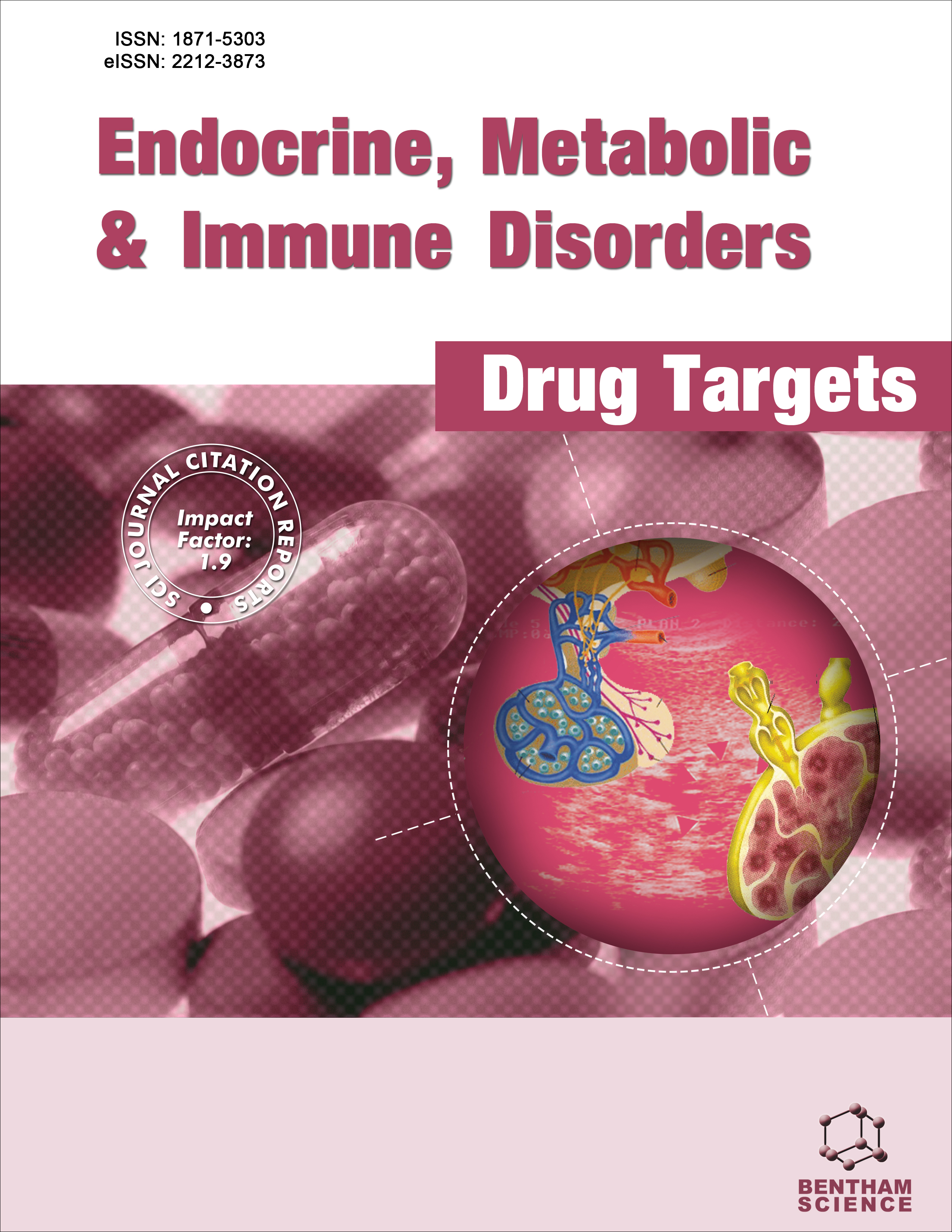- Home
- A-Z Publications
- Endocrine, Metabolic & Immune Disorders-Drug Targets (Formerly Current Drug Targets - Immune, Endocrine & Metabolic Disorders)
- Previous Issues
- Volume 9, Issue 3, 2009
Endocrine, Metabolic & Immune Disorders-Drug Targets (Formerly Current Drug Targets - Immune, Endocrine & Metabolic Disorders) - Volume 9, Issue 3, 2009
Volume 9, Issue 3, 2009
-
-
Factors Modulating Fibrates Response: Therapeutic Implications and Alternative Strategies
More LessAuthors: M. I. Panadero, M. C. Gonzalez, E. Herrera and C. BocosPeroxisome proliferator-activated receptor alpha (PPAR??) regulates transcription of genes involved both in lipid and glucose metabolism as well as in inflammation. Fibrates are PPARα ligands used to normalize lipid and glucose parameters and exert antiinflammatory effects. In fact, fibrates have already been demonstrated to benefit metabolic syndrome, type 2 diabetes and cardiovascular diseases. This article reviews the Read More
-
-
-
Immunomodulatory and Anti-Inflammatory Activities of Statins
More LessAuthors: Emilia Mira and Santos ManesThe statins are a group of inhibitors of 3-hydroxy-3-methylglutaryl coenzyme A reductase that are used extensively in medical practice because of their ability to reduce cardiovascular mortality and stroke. Although this protective activity was initially ascribed to the inhibition of cholesterol biosynthesis in the liver, clinical trials and basic research studies indicate that, beyond their cholesterol-lowering activity, statins might af Read More
-
-
-
Differential Conservation of Nucleotides and Conservation/Mutation Correlations Between Nucleotides, with Special Reference to CXC 1 and 4 and FP Receptors Involved in Immune Regulation
More LessRandom mutations of the first nucleotide of a coding triplet alter the hydropathic character of 27 % of the hydrophobic amino acids and of 23 % of the hydrophilic amino acids, while random mutations of the second nucleotide alter the hydropathic character of 82 % of the hydrophobic amino acids and of 47 % of the hydrophilic amino acids. In cases of a change of the hydropathic character, a second random mutation in the p Read More
-
-
-
Genetic Alterations in Differentiated Thyroid Cancers
More LessAuthors: Behrouz Salehian, Zhong Liu and Fouad KandeelDifferentiated thyroid cancers are the predominant malignancies of the thyroid. Due to advances in the understanding of the activation of the cell proliferation pathway at a molecular level, multiple genetic alterations have been linked to the development of thyroid carcinogenesis. Although the genetic alterations can be categorized into 7 categories, the BRAF mutation, RET/PTC, Pax8/PPARGamma, and dysfunctional Fas pathwa Read More
-
-
-
Human Exposure to Endocrine Disruptors and Breast Milk
More LessAuthors: M. Stefanidou, C. Maravelias and C. SpiliopoulouEndocrine system is one of the most sensitive communication networks of the human body, which influences all aspects of human health and well-being, including reproductive potential, cognitive functions, thyroid and metabolism, digestion and hormonal balance. In recent years, basic laboratory research has been focused on the potential relationship between environmental contaminants and cellular endocrine functio Read More
-
-
-
Role of Iodine, Selenium and Other Micronutrients in Thyroid Function and Disorders
More LessMicronutrients, mostly iodine and selenium, are required for thyroid hormone synthesis and function. Iodine is an essential component of thyroid hormones and its deficiency is considered as the most common cause of preventable brain damage in the world. Nowadays about 800 million people are affected by iodine deficiency disorders that include goiter, hypothyroidism, mental retardation, and a wide spectrum of other Read More
-
-
-
TNF alpha Inhibition as Treatment Modality for Certain Rheumatologic and Gastrointestinal Diseases
More LessAuthors: Marcus W. Wiedmann, Joachim Mossner, Christoph Baerwald and Matthias PiererWith the development of biologicals that specifically target tumor necrosis factor (TNF)α, our therapeutic approach to inflammatory diseases has dramatically changed. There are currently three anti-TNFα drugs available: etanercept, infliximab, and adalimumab. Etanercept is a recombinant fusion protein that can be used alone or in combination with other medications for conditions such as rheumatoid arthritis, juvenile rheu Read More
-
Volumes & issues
-
Volume 25 (2025)
-
Volume 24 (2024)
-
Volume 23 (2023)
-
Volume 22 (2022)
-
Volume 21 (2021)
-
Volume 20 (2020)
-
Volume 19 (2019)
-
Volume 18 (2018)
-
Volume 17 (2017)
-
Volume 16 (2016)
-
Volume 15 (2015)
-
Volume 14 (2014)
-
Volume 13 (2013)
-
Volume 12 (2012)
-
Volume 11 (2011)
-
Volume 10 (2010)
-
Volume 9 (2009)
-
Volume 8 (2008)
-
Volume 7 (2007)
-
Volume 6 (2006)
Most Read This Month
Article
content/journals/emiddt
Journal
10
5
false
en


